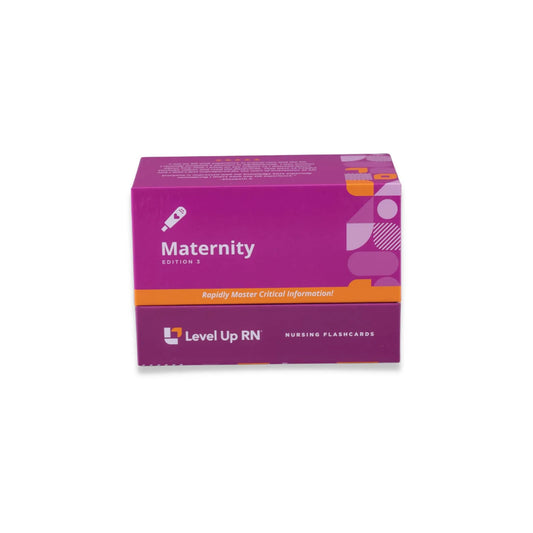In this article and video, Meris Shuwarger, BSN, RN, CEN, TCRN covers the risk factors, signs and symptoms, and nursing care for labor dystocia, prolapsed umbilical cord, and cesarean section (c-section) birth.
This series follows along with our Maternity Nursing Flashcards which are intended to help RN and PN nursing students study for nursing school exams, including the ATI, HESI, and NCLEX.
Maternity Nursing - Flashcards
Labor dystocia
Labor dystocia means prolonged or difficult labor. You may see it referred to as dystocia on its own—same thing. Dys- means abnormal, difficult, or painful, and -tocia means labor.
Risk factors
Risk factors for labor dystocia include fetal macrosomia, maternal fatigue, uterine abnormalities, cephalopelvic disproportion, fetal malpresentation, or anesthetic/analgesic use.
Fetal macrosomia
Fetal macrosomia means a large baby! Typically this means greater than 9-10lbs. Large babies are harder to push.
Maternal fatigue
If a patient has been in labor for many hours, possibly days, it's likely they can become fatigued during delivery, which makes pushing more difficult.
Uterine abnormalities
If the structure of the uterus is nonstandard or there is a weak point, this can be a contributing factor to labor dystocia.
Cephalopelvic disproportion
Cephalo- means head, so cephalopelvic disproportion means the baby's head is too big to fit through the pelvic opening.
Fetal malpresentation
Fetal malpresentation means the baby isn't in a good position for labor—this can prolong labor or make it more difficult.
Anesthetic/Analgesic use
Anesthetic or analgesic use might contribute to labor dystocia because, for example, an epidural that is too strong can reduce the effectiveness of pushing.
Signs and symptoms
Signs and symptoms of labor dystocia are that labor is not progressing: dilation is not progressing as expected, effacement is not progressing as expected, fetal descent is not progressing as expected, or fetal station isn't changing as expected.
Nursing care
Nursing care for labor dystocia includes encouraging ambulation and position changes, special procedures for shoulder dystocia, assisting with amniotomy, providing oxytocin as needed, or helping prepare for an assisted delivery or surgical birth via C section.
Encouraging ambulation and position changes
If a patient has a heavy epidural, they may not be able to walk, but as a nurse, you can help the patient change positions in a way that helps to move or rotate the baby to an easier position for labor. In order to get the baby from the posterior to the anterior position (referring to where the back of the head is), the correct patient positioning is on their hands and knees
Shoulder dystocia
Shoulder dystocia is when the fetal shoulder gets stuck on the maternal pelvis—this is a true emergency. This can cause damage to the nerves, muscles, and bones. It can even cause bone breaks. When you have a patient with shoulder dystocia, as a nurse you may be asked to put pressure on the suprapubic region—right above the pubic bone, pushing down, which ideally helps pop the shoulder down off of the pelvic bone.
The McRoberts maneuver
The McRoberts maneuver is a technique to assist in correcting shoulder dystocia. This is where the patient's thighs are flexed towards their abdomen while simultaneously shifting the hips away from the body (hip abduction). This shifting of the pelvic angle, often combined with the suprapubic pressure described above, can help dislodge the baby's shoulder from under the pelvic bone.
Assisting with amniotomy
An amniotomy is the intentional rupture of the amniotic sac (breaking the water) by a provider. Nursing care for an amniotomy includes ensuring the presenting part of the fetus is engaged prior to the amniotomy, monitoring fetal heart rate before and immediately after the amniotomy for bradycardia and variable decelerations, and monitoring temperature every 2 hours or per facility policy.
An associated risk of an amniotomy is a cord prolapse, which we will cover later in this article.
Oxytocin
Oxytocin might be administered during labor dystocia because it is a uterine stimulant—it is used to increase the strength, frequency, and length of uterine contractions during labor. Nursing care for the administration of oxytocin includes monitoring fetal heart rate and contractions, and the administration of a tocolytic agent (e.g., terbutaline, magnesium sulfate, nifedipine) to decrease uterine activity if needed.
Oxytocin is covered in our Pharmacology - Nursing Flashcards.
Preparing for assisted delivery/surgical birth
Assisted deliveries include vacuum-assisted delivery and forceps-assisted delivery. A C-Section is a surgical birth, which we'll cover later in this article. One of these methods may be indicated for prolonged labor dystocia.
Prolapsed umbilical cord
A prolapsed umbilical cord means that the cord itself is protruding through the cervix before the baby. The baby is still fully inside the uterus, but the cord is poking out through the cervix. This can lead to cord compression, and cord compression can lead to fetal hypoxia, fetal distress, or compromised fetal circulation. Remember that the purpose of the umbilical cord is to deliver rich oxygenated blood to the baby and to get rid of waste and carbon dioxide. So, prolapse and compression of the cord are not good for the baby.
Signs and symptoms
Signs and symptoms of a prolapsed umbilical cord are: visualization of the umbilical cord (you can see the cord protruding, but not the baby), palpation of the umbilical cord with vaginal examination (a cervical check during which you feel a protrusion that is not the baby); and/or variable or prolonged decelerations in fetal heart rate.
Nursing care
A prolapsed umbilical cord is a medical emergency. The first and most important step is to call for help immediately. Don't leave the patient, use your facility's method — emergency/panic button in the room or on your badge, or calling out for help.
Apply sterile gloves, insert fingers into the patient's vagina, put fingers on either side of the cord, and lift the fetal presenting part off of that cord. You are basically supporting the fetal weight with your fingers to prevent it from compressing the cord, which helps maintain oxygenation to the baby.
Next is to position the patient in knee-chest position (also called Trendelenburg position). This helps use gravity to shift the weight of the baby off of the prolapsed cord.
If the cord is exposed outside of the vagina, then make sure it is covered so that it does not dry or become exposed to germs. A warm, saline-soaked towel can go over the exposed cord to protect it and help maintain the right environment for it.
Administer oxygen to the patient and prepare for the birth of the infant (which may be via emergency C-section). In the video, Meris describes how during a prolapsed umbilical cord situation, the nurse who is lifting that presenting part off of the cord may ride on the stretcher to the OR, continuing to lift that presenting part off of the cord until the provider delivers the baby via C-section.
Prolapsed umbilical cords are true medical emergencies that can lead to fetal death if there is not appropriate intervention.
Cesarean section (C-section) births
A C-section is the delivery of the infant through an incision made in the abdomen and uterine wall. It is a surgical delivery of the baby.
Anesthesia is used for a C-section—either spinal, epidural, or general anesthesia.
Spinal anesthesia is typically for a planned C-section, and includes a shot into the cerebrospinal fluid which provides anesthesia up to midchest level.
Epidural anesthesia may be used when a patient was attempting vaginal delivery, had an epidural catheter placed, and now requires a C-section.
In rare cases, general anesthesia may be needed in an emergency situation. In the video above, Meris shares the slang term "splash-and-dash" C-section, which refers to the fast nature of the situation. There may not be time for spinal anesthesia and other measures, so the patient is put to sleep with general anesthesia, Betadine is "splashed" (quickly applied) to the abdomen, and the provider gets going with the procedure. The baby needs to come out ASAP.
Indications
Indications for a C-section birth include maternal, fetal, and/or placental factors that make a vaginal birth contraindicated and/or dangerous for the patient or the baby. C-sections may be planned in advance, or might be unplanned in that a vaginal birth is attempted, but certain circumstances (e.g., a prolapsed cord as described above) lead to a C-section being indicated.
Risk factors
Risk factors for needing a C-section include labor dystocia, fetal malpresentation, failure to progress (lack of desired dilation and effacement); fetal distress; and previous C-section. Having had a previous C-section does not automatically make another C-section the only option, but it can be indicated in order to prevent uterine rupture or separation of the previous C-section scar.
A vaginal birth after a previous C-section is referred to as a VBAC, but it comes with risks, and there are requirements for a patient to meet to be a candidate for it.
Complications
As with any surgical procedure, complications of a C-section can include hemorrhage and infection.
Nursing care
When providing nursing care during a C-section, prepare the surgical site, start IV fluids, insert a Foley catheter, administer preoperative medications.
Post-procedure, provide analgesics for incisional pain, and inspect abdominal dressing for signs of infection, purulent drainage, wound dehiscence, or similar. This is similar to what you would do post-operation for many other procedures.



1 comment
l love the way the break your teaching down. All your lectures interests me